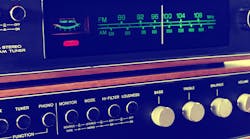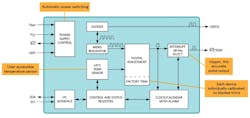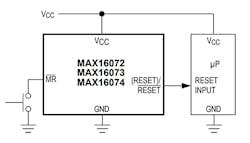Download this article in PDF format.
Today it seems that everything electronic is digital—a reasonable assumption considering it’s hard to find a turnable knob anywhere and values are displayed in digits everywhere. The underlying assumptions, at least for those without a technical bent, are that digital is modern, analog is archaic (the way things were done before we had something better), and there’s probably no analog “stuff” in electronic products anymore. Fortunately for the designers who work with analog components and the manufacturers that make them, this is far from the case, and it’s likely to remain that way.
After all, the earth and its inhabitants are analog. So, the goal of converting something from analog to digital form is an attempt to re-create the original as faithfully as possible. Of course, from an electronics perspective, once this is achieved, it opens new horizons for designers because much more can be done with a digital representation of an analog source.
But just because something can be converted to the digital domain doesn’t mean it should be. Just ask the audiophile who still uses vacuum tube amplifiers and whose media is the vinyl disc (which, it should be noted, is making a comeback).
Sponsored Resources:
- Finish Strong with Heroes of Analog
- Using the MAX13054AESHLD Evaluation Kit
- The Amplifier Power of Three: Current, Bandwidth, and Size
Indispensable Devices
Analog components are, consequently, essential—digital devices simply cannot do certain things, at least not yet. For example, state-of-the-art analog-to-digital converters (ADCs) are incredibly capable devices and able to convert analog signals at very high frequencies to digital form. Frequencies above say, 12 GHz, are nevertheless too high right now for even the best ADCs to convert in order to capture signals off the air without downconversion. ADCs also require analog circuits to help in the conversion.
Then there are switch-mode power supplies, which are still analog as high current cannot be handled by digital electronics. And although digital filters hold many advantages over their analog counterparts, they still often need to convert the input signal from its analog form. Analog anti-aliasing filters are required before the ADC in oversampled sampled-data systems, as is a reconstruction (anti-imaging) filter after the digital-to-analog converter (DAC). Analog filters also have a fraction of the latency of digital filters, so they’re faster.
Amplifiers represent classic examples of analog capability, whether they’re boosting audio systems, smartphones, or broadcast transmitters. Even amplifiers in the higher classes, like S through T that convert an analog signal to digital form (and back again), still rely on power transistors to amplify them. It should be noted, however, that “digital” power amplifiers have significant benefits, but remain in the developmental stage. The MAX40007 is a classic example of an op amp, one of the mainstays of analog design, created for low-power products such as wearables, medical devices, and others, often powered by a coin-cell battery. It consumes only 700 nA from a from a single 1.8- to 5-V dc supply and measures just 1.1 × 0.76 mm.
1. Shown is a functional diagram of the DS3231M real-time clock.
In a similar vein, any device that needs to maintain an accurate time reference needs a real-time clock, which consumes little power, offloads the time-keeping function from other devices, and can even be accurate than other types of sources. Most use crystals to provide the reference, but MEMS devices are increasing their presence as well. MEMS oscillators are also smaller than crystal oscillators and consume less power. Maxim’s DS3231M (Fig. 1) is an extremely accurate, MEMS-based, I2C real-time clock with accuracy of ±5 ppm and outputs of 1 Hz and 32.768 kHz.
There are plenty of other examples as well, like the “digital thermometer” that converts the signal received from an analog sensor, and the exponentially growing number of analog sensors being used in IoT edge devices to sense changes in various (analog) parameters. They may have digital outputs, but that’s because the analog input signal has been converted to the digital domain.
Nanopower Supervisors
Of course, other devices combine the benefits of analog and digital technology to produce a result that neither one could achieve on its own. A good example is Maxim’s family of “nanopower” supervisory circuits. These small, inexpensive devices are extremely valuable as they monitor critical electronic loads in microcontrollers, microprocessors, FPGAs, and ASICs. On power-up, supervisors ensure acceptable voltages are maintained before the processor performs any further functioning.
2. This illustrates a typical application circuit for the MAX16072 op amp.
They also detect when a voltage level is unacceptably high or low and alert the processor to reset. Watchdog ICs supervise processor activity and will indicate when a system is not working properly. The MAX16072 (Fig. 2), for example, housed in a 1- × 1-mm package and consuming a tiny 0.7 µA, it includes a microprocessor, band-gap reference, comparator, and resistors that set the threshold voltage. It’s designed to the confines of such products as smartphones and other devices operating between 1.8 and 3.6 VDC in which power is a precious commodity.
Sponsored Resources:
- Finish Strong with Heroes of Analog
- Using the MAX13054AESHLD Evaluation Kit
- The Amplifier Power of Three: Current, Bandwidth, and Size
Related Reference:


